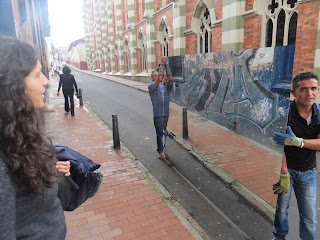 |
| A.G. Ordoñez prefers not to answer. |
For the record, it's hard to think of another historical even that's better documented than the Holocaust: there are the survivors' statements, the Nuremberg and other trials, confessions by Nazi perpetrators, voluminous Nazi records, the concentration camps - which are there to be visited, and, of course, the fact that the large Jewish populations which existed across Europe disappeared during World War II.
According to historical investigators, the Nazis massacred some 6 million Jews and hundreds of thousands of gays, Gypsies, communists and disabled people.
 |
| A lie? Piled corpses of victims of the Nazi Holocaust. |
Ordoñez, a hard line conservative and traditionalist Catholic, got himself into this situation during an April 8Blu Radio. Ordóñez has said that he feels like he's 'on trial at Nuremberg' because of criticisms of his views opposing abortion, gay rights and a law banning discrimination.
interview by writer Héctor Abad Faciolince on Abad asked Ordóñez "Do you believe that the Jewish Holocaust, by the government of Hitler, was an exaggeration?"
 |
| Armando Valenzuela Ruiz, Colombian neo Nazi. (Photo from a Neo Nazi site, where he shares the page with Hitler, Mussolini and Goebbels.) |
Abad's didn't come out of the blue, as Daniel Coronell, a newspaper columnist, leader of Colombia's tiny Jewish community and executive of Univision in Miami, pointed out in a column in Semana magazine. After all, Ordóñez is a follower of conservative Catholic Bishop Marcel Lefebvre, some of whose other followers have denied the Holocaust. Even more incriminating are Ordoñez's associations with Armando Valenzuela Ruiz, a founder of Colombia's paramilitaries and life-long Holocaust denier who is venerated by Colombia's neo-Nazis.
In 1975, Ordoñez, Valenzuela and others signed a letter congratulating Ecuador's dictator for escaping a coup attempt. The letter, from 'Colombian nationalists' was published in Valenzuela's openly anti-semitic newspaper, according to Coronell. (The letter congratulated the dictator for triumphing over 'International Masonry,' but the bizarre conspiracy theories about Freemasons deserve their own blogpost.)
The letter was written 38 years ago, which gives Ordoñez plenty of time to
 |
| The February issue of Semana magazine calls Ordoñez 'all powerful.' |
Does Ordoñez deny the Holocaust? He made it easy to believe that he does. Colombia's Federation of Jewish Communities called on Ordoñez to state his position on the Holocaust. He hasn't responded.
People who seize onto the bizarre idea of Holocaust denial usually don't do it based on historical research, but motivated by anti-semitism.
 |
| A sign at Bogotá's May Day parade says 'Hitler killed 6 million Jews. Ordoñez killed Colombia's democracy.' |
By Mike Ceaser, of Bogotá Bike Tours


























































